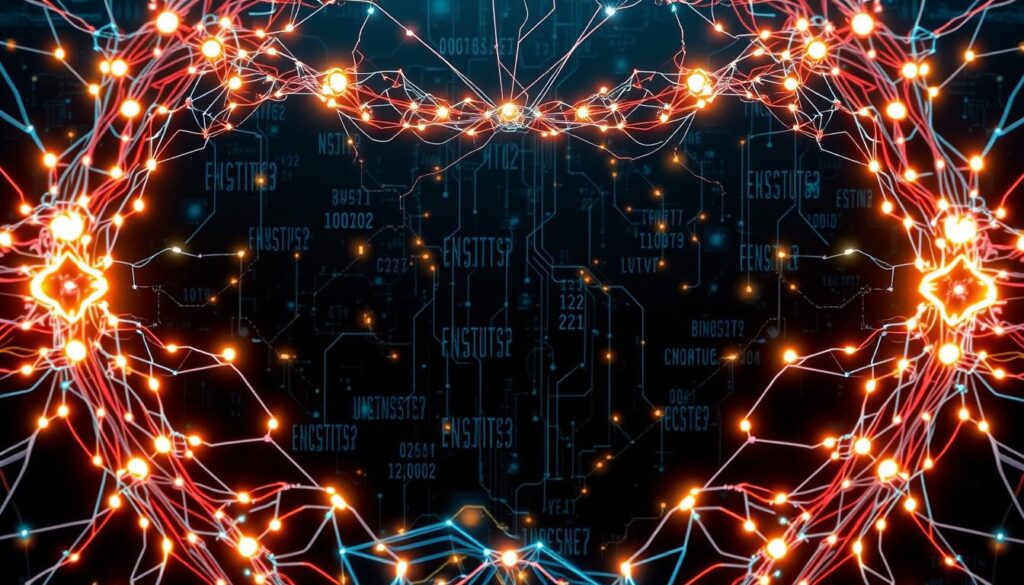Welcome to the world of machine learning. It’s a field that’s changing how we solve problems and make decisions. In this guide, we’ll cover the basics, key algorithms, and how it’s used in real life. This guide is perfect for anyone new to machine learning or looking to learn more.
Key Takeaways
- Gain a solid understanding of the core principles of machine learning.
- Explore the applications of machine learning in various industries.
- Familiarize yourself with the fundamental machine learning algorithms.
- Discover the role of artificial intelligence and its relationship with machine learning.
- Understand the concepts of supervised and unsupervised learning.
- Explore the powerful capabilities of deep learning and neural networks.
- Learn about the resources and tools available for beginners in machine learning.
What is Machine Learning?
Machine learning is a fascinating area of Artificial Intelligence. It lets computers learn and get better without being told exactly what to do. They use data and algorithms to find patterns, predict outcomes, and adapt to new situations.
Defining Machine Learning
At its heart, machine learning trains computer models to do certain tasks by showing them lots of data. These models use advanced algorithms to spot trends, understand complex relationships, and make smart choices. They do this without needing specific rules or instructions.
Applications of Machine Learning
Machine learning has many uses across different fields and industries. It helps with everything from suggesting products online to making self-driving cars. It’s also used in:
- Predictive analytics for financial forecasting and risk management
- Medical diagnosis and personalized treatment plans
- Natural language processing for chatbots and virtual assistants
- Image and speech recognition for enhanced user experiences
- Fraud detection and cybersecurity threat identification
As Artificial Intelligence keeps growing, machine learning’s ability to change industries and enhance our lives is endless.
Understanding Machine Learning: A Simple Guide for Beginners
Machine learning is a field that lets computers learn and adapt on their own. It’s not about programming them step by step. Instead, it’s about teaching them to figure things out by themselves.
At its core, machine learning uses algorithms and models to help systems do tasks well. These systems learn from data, spotting patterns and making predictions. This way, they can make decisions without being told exactly what to do.
The Machine Learning Process
The machine learning process has a few main steps:
- Data Gathering: First, we collect and organize data for the model to learn from.
- Model Selection: Next, we pick the right algorithm or model for the task.
- Model Training: Then, we feed the data into the model, letting it learn and improve.
- Model Evaluation: After that, we test the model on new data to see how well it works.
- Model Deployment: Finally, we use the model in real-world applications.
This process helps machine learning systems solve many problems. They can recognize images, understand language, and even make predictions and decisions.
Types of Machine Learning
Machine learning algorithms fall into three main types:
- Supervised Learning: These algorithms learn from labeled data, aiming to predict or classify new inputs.
- Unsupervised Learning: These algorithms find patterns in unlabeled data, without any target variables.
- Reinforcement Learning: These algorithms learn by interacting with an environment, getting feedback to improve their decisions.
Knowing these types is key to choosing the right approach for a problem. It helps unlock the full potential of machine learning.
We’ve covered the basics of machine learning. Now, we’ll explore its practical uses, its connection to AI, and the algorithms that make it work.
Artificial Intelligence Fundamentals
Artificial Intelligence (AI) and machine learning are closely linked. They have changed how we solve problems and make decisions. AI aims to make machines intelligent. Machine learning is a key method to improve AI.
The Relationship Between AI and Machine Learning
Machine learning is a part of AI. It lets computers learn and get better over time without being told how. By using data, these systems can spot patterns, predict outcomes, and do tasks on their own. This makes AI smarter.
The bond between AI and machine learning is strong. Machine learning uses different methods to help AI systems see, learn, and decide like humans. At the same time, AI’s growth, like deep learning, boosts machine learning. This creates a cycle of progress and innovation.
| Characteristic | Artificial Intelligence | Machine Learning |
|---|---|---|
| Definition | A broad field of study focused on creating intelligent machines that can perform tasks that typically require human intelligence. | A subset of AI that enables computers to learn and improve from experience without being explicitly programmed. |
| Approach | Aims to create systems that can perceive, learn, and make decisions like humans. | Develops algorithms and statistical models that allow computers to perform specific tasks efficiently by learning from data. |
| Applications | Wide range of applications, including natural language processing, computer vision, robotics, and decision-making. | Primarily used for predictive modeling, pattern recognition, and automation of tasks. |
Understanding the link between AI and machine learning helps us see how these fields are changing technology. They are driving innovation in many industries.
Machine Learning Algorithms
Machine learning is a powerful tool that uses many algorithms to help computers learn and predict. We’ll explore the different types of machine learning algorithms. We’ll see how they solve various problems.
Supervised learning is a key category. These algorithms learn from labeled data, where the answers are known. They can be classified into two types: classification and regression. Classification predicts categories, like spam emails. Regression predicts continuous values, like stock prices.
Unsupervised learning is another major category. These algorithms find hidden patterns in data without labels. Clustering algorithms, like K-means, group similar data points together.
Reinforcement learning is the third type. It involves an agent learning from rewards and punishments in an environment. It’s used in games and robotics for decision-making.
There are many specific machine learning algorithms, each with its own strengths. Examples include decision trees, random forests, and neural networks. The right algorithm depends on the problem, data, and desired outcomes.
| Algorithm | Category | Use Case |
|---|---|---|
| Logistic Regression | Supervised Learning | Binary Classification |
| K-Nearest Neighbors | Supervised Learning | Classification and Regression |
| Decision Trees | Supervised Learning | Classification and Regression |
| K-Means | Unsupervised Learning | Clustering |
| Q-Learning | Reinforcement Learning | Decision Making |
Machine learning algorithms are diverse and can solve many problems. Knowing the different algorithms and their uses is crucial for anyone interested in machine learning.
Data Mining Techniques
Data mining is key in machine learning. It helps find valuable insights and patterns in big datasets. We’ll look at different methods to find hidden treasures in your data.
Exploring Data Mining Methods
Classification is a basic technique. It sorts data into groups for better decisions and predictions. For example, a store might use it to find who will buy a certain product.
Clustering groups similar data points together. It’s great for finding different customer groups based on what they buy. This helps businesses understand their customers better.
Association rule mining finds hidden connections in data. It’s used in systems that suggest products based on what you’ve bought before. This helps customers find things they might like.
Using these techniques, businesses can understand their data better. They can make smarter choices and find valuable insights. This leads to better results.
“Data mining is the process of discovering patterns in large data sets involving methods at the intersection of machine learning, statistics, and database systems.”
Understanding data mining techniques is important in machine learning. We’ll keep exploring as we move on to predictive modeling. We’ll also look at supervised and unsupervised learning.
Predictive Modeling
Predictive modeling is at the core of machine learning. It uses past data to predict future outcomes with great accuracy. This skill helps us make smart decisions that boost business success.
This process involves many statistical and machine learning algorithms. First, we collect and clean the data. Then, we pick the right methods, like regression for numbers or classification for categories.
Model evaluation is crucial. We test our models with cross-validation and hold-out testing. This ensures they work well with new data. Through this, we improve our models’ accuracy and reliability.
Predictive Modeling has many uses. It helps forecast sales and predict when customers might leave. These models guide us in making decisions that grow our business. They help us find new chances, reduce risks, and stay ahead.

In the world of machine learning, Predictive Modeling is key. It turns data into useful insights. This helps our companies grow and succeed in the long run.
Supervised Learning
At the heart of machine learning is a key approach called supervised learning. We train an algorithm on labeled data. This gives it the skill to make accurate predictions on new data. Supervised learning includes two main methods: classification and regression.
Classification and Regression Techniques
In classification, the algorithm sorts data into clear categories or labels. It’s great for tasks like spotting spam emails or recognizing handwritten digits. On the other hand, regression lets the algorithm predict continuous values, like stock prices or disease progression.
- Classification models sort inputs into specific categories, like “spam” or “not spam”.
- Regression models forecast numerical values, such as house prices or patient recovery chances.
Supervised learning algorithms are used in many real-world tasks. They help with image recognition, natural language processing, and financial forecasting. By using labeled data, these methods help machines learn and predict accurately. This changes how we solve complex problems.
| Technique | Goal | Example Applications |
|---|---|---|
| Classification | Assign inputs to discrete categories | Spam detection, image recognition, disease diagnosis |
| Regression | Predict continuous numerical values | Stock price forecasting, housing price estimation, disease progression modeling |
“The beauty of supervised learning is that it allows us to leverage the power of data to create intelligent systems that can solve complex problems with remarkable accuracy.”
Unsupervised Learning
Unsupervised Learning is a key part of machine learning. It helps us find interesting insights in big datasets without labels. This way, we can see patterns and groupings that lead to big discoveries.
At the heart of Unsupervised Learning are methods like clustering and reducing dimensions. Clustering groups similar data points, showing us natural groups. Dimensionality reduction makes big datasets smaller by focusing on key features.
This approach is very useful in many fields, like retail and healthcare. It helps us find patterns in customer behavior, spot odd transactions, and find new medical discoveries. The uses are endless, leading to new ideas and solving big problems.
As machine learning keeps growing, Unsupervised Learning shows us new ways to explore and find hidden data gems. It shows the amazing power of machine learning to change how we see the world.
| Unsupervised Learning Techniques | Applications |
|---|---|
|
|
“Unsupervised Learning is like exploring a vast, uncharted territory – the possibilities are limitless, and the discoveries can be truly transformative.”
Exploring Unsupervised Learning opens up a world of possibilities in our data. By using this approach, we can start a new era of discovery. It will drive innovation and change how we see and interact with the world.
Deep Learning
Deep learning is a fascinating field in machine learning. It has changed how we solve complex problems. It uses artificial neural networks to find important insights in lots of data. These networks are like the human brain, helping us solve big challenges in areas like computer vision and speech recognition.
Unraveling the Mysteries of Neural Networks
Neural networks are the heart of deep learning. They learn and adapt like our brains do. These networks have layers that process data in different ways. As we go deeper, the layers get more complex, helping us solve harder problems.
Neural networks are very versatile. They can be used for many things, like recognizing images or understanding language. By using these networks, we can explore new areas in Deep Learning and Neural Networks.
“Deep learning is the future of artificial intelligence, and neural networks are the key to unlocking that future.”
The importance of Deep Learning and Neural Networks is huge. They have the power to change industries and make new discoveries. They could make the impossible possible in the future.

Real-World Applications of Machine Learning
Machine learning is a powerful technology that’s changing the world. It’s used in predictive modeling, supervised learning, and unsupervised learning. This tech is making a big impact in many industries and solving tough problems globally.
In healthcare, machine learning is a game-changer. It helps doctors and researchers by analyzing huge amounts of medical data. This leads to better patient care and more efficient healthcare systems.
The financial world is also benefiting from machine learning. It’s used for predictive modeling to forecast market trends and detect fraud. Banks and financial institutions use it to make smart decisions and stay competitive.
E-commerce companies are using machine learning too. They use predictive modeling and recommendation systems to suggest products and improve customer experience. This helps them understand what customers want and deliver it to them.
Machine learning is also behind self-driving cars and intelligent personal assistants. As technology gets better, we’ll see even more amazing uses of machine learning in the future.
“Machine learning is the future, not only for research, but in many of the most exciting application areas as well.” – Andrew Ng, Co-founder of Coursera and former Chief Scientist at Baidu
Getting Started with Machine Learning
Are you curious about machine learning but don’t know where to start? Don’t worry! We’ve put together a list of resources and tools to help you begin your journey. This is true whether you have experience or not.
Resources for Aspiring Machine Learning Enthusiasts
Start learning the basics of machine learning with these excellent online courses and tutorials:
- Coursera’s “Machine Learning” by Andrew Ng – a highly praised course that covers the basics of machine learning.
- Udemy’s “The Complete Machine Learning Course” – a beginner-friendly course that teaches a wide range of machine learning topics.
- Kaggle’s “Kaggle Learn” – interactive tutorials and hands-on projects that let you apply machine learning in real-world scenarios.
If you prefer learning from books, here are some great titles:
- “Introduction to Machine Learning” by Ethem Alpaydin – a detailed textbook that explores the fundamental concepts and algorithms of machine learning.
- “Machine Learning for Absolute Beginners” by Oliver Theobald – a clear and simple guide that makes machine learning easy to understand for beginners.
- “Hands-On Machine Learning with Scikit-Learn, Keras, and TensorFlow” by Aurélien Géron – a practical guide that teaches you how to build and deploy machine learning models using popular Python libraries.
Essential Tools for Machine Learning Beginners
Get familiar with these powerful machine learning tools and platforms to enhance your learning:
| Tool | Description |
|---|---|
| Python | A popular programming language with a vast ecosystem of machine learning libraries and frameworks, such as NumPy, Pandas, and Scikit-learn. |
| Jupyter Notebook | An interactive computing environment that allows you to write and execute code, visualize data, and collaborate with others. |
| TensorFlow | A powerful open-source library for building and deploying machine learning models, especially useful for deep learning applications. |
| Azure Machine Learning | A cloud-based platform that offers a comprehensive suite of tools and services for building, deploying, and managing machine learning models. |
With these resources and tools, you’re ready to start your machine learning journey. You’ll be on your way to becoming a machine learning enthusiast and exploring new and exciting ideas.
Conclusion
In this guide, we’ve covered the basics of machine learning. We looked at how Artificial Intelligence Fundamentals relate to it. We also explored various techniques like Machine Learning Algorithms and Data Mining Techniques.
We discussed Predictive Modeling, Supervised Learning, Unsupervised Learning, Deep Learning, and Neural Networks. This should give you a good start in understanding machine learning.
If you’re new to machine learning or want to learn more, this guide is for you. It offers insights and resources to help you get started. We’ve made it easy for beginners to understand the key concepts and how to apply them.
As you learn more about machine learning, stay curious and keep learning. There are many online resources and communities to help you. With hard work and dedication, you can become skilled in machine learning and make a difference in your field.



